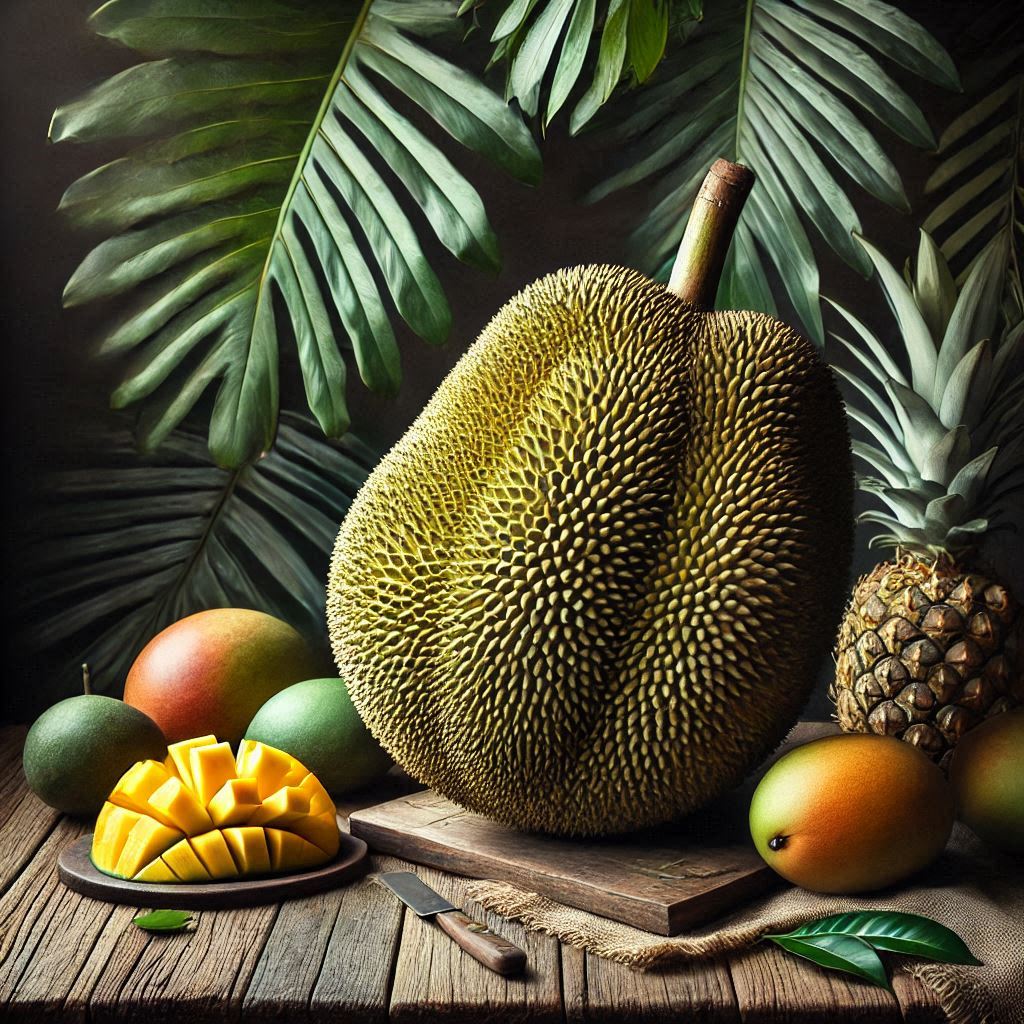
Introduction: What is Overripe Jackfruit?
Jackfruit, a tropical fruit known for its impressive size and versatility, is a staple in many Asian cuisines. But what happens when this giant fruit becomes overripe? Understanding overripe jackfruit is essential for those interested in exploring its diverse culinary applications.
Overripe jackfruit is characterized by its intensely sweet aroma and softer texture compared to its ripe counterpart. While ripe jackfruit has a firm flesh that can be used in both savory and sweet dishes, overripe jackfruit takes on a more sugary profile, making it ideal for desserts or jams. The color of the flesh also deepens from a bright yellow to an amber hue as it ripens further.
Identifying an overripe jackfruit involves looking at several key characteristics. The skin of the fruit may become slightly wrinkled or develop brown patches, indicating that the sugars within have fully developed. Additionally, the fruit may emit a strong fragrance, signaling that it’s ready to be consumed quickly or preserved.
Embracing the unique qualities of overripe jackfruit can open up new culinary possibilities and help reduce food waste by utilizing every stage of this remarkable tropical fruit’s lifecycle.
How to Identify Overripe Jackfruit: Key Signs and Indicators
Identifying the ripeness of jackfruit can be a bit tricky, especially if you’re not familiar with its unique characteristics. However, understanding the key signs and indicators can help you distinguish between ripe and overripe jackfruit effectively.
One of the primary jackfruit ripeness signs is its color. A ripe jackfruit typically exhibits a yellowish-brown hue on its outer skin, while an overripe fruit tends to develop dark brown or black patches. These spots are a clear indicator that the fruit has surpassed its peak ripeness.
Another important factor in identifying overripe fruit is texture. When gently pressed, a ripe jackfruit should feel slightly soft but still firm overall. In contrast, an overripe jackfruit will often feel mushy or overly soft to the touch, indicating that it may have started to ferment internally.
The smell of the fruit also plays a crucial role in determining whether it’s ripe or overripe. A naturally sweet and fragrant aroma signifies ripeness; however, if the scent becomes overly pungent or sour, it suggests that the jackfruit is past its prime.
Lastly, examining the stem can provide additional clues on how to tell if jackfruit is overripe. As a jackfruit matures beyond ripeness, its stem may appear dry and brittle rather than fresh and green.
By keeping these indicators in mind—color changes, texture variation, scent alterations, and stem condition—you’ll be better equipped to identify when your jackfruit has reached an undesirable level of overripeness. This knowledge ensures you enjoy this tropical delicacy at its best flavor and texture profile.
The Nutritional Profile of Overripe Jackfruit
The nutritional profile of overripe jackfruit is a fascinating topic for those interested in tropical fruits and their health benefits. While often overlooked, the ripening process enhances certain qualities of the fruit, making it a unique addition to a balanced diet. Jackfruit, especially when overripe, is rich in essential nutrients that contribute to overall well-being.
One of the most notable aspects of jackfruit nutrition facts is its high fiber content. As a high fiber fruit, jackfruit aids in digestion and promotes gut health by ensuring smooth bowel movements. This makes it an excellent choice for those looking to improve their digestive system naturally.
In terms of nutrients in ripe fruit, overripe jackfruit is packed with vitamins such as vitamin C and B-complex vitamins like B6 (pyridoxine). Vitamin C acts as a powerful antioxidant that helps boost the immune system and protects the body against free radicals. Meanwhile, vitamin B6 plays a crucial role in brain development and function.
Moreover, the health benefits of jackfruit extend beyond its vitamin content. It contains important minerals like potassium and magnesium that support cardiovascular health by regulating blood pressure levels and maintaining proper muscle function.
Incorporating overripe jackfruit into your diet can be both delicious and beneficial. Whether consumed fresh or used creatively in smoothies or desserts, this tropical fruit offers a sweet way to enhance your nutrient intake while enjoying its unique flavor profile.
Culinary Uses for Overripe Jackfruit: Delicious Recipes and Ideas
When it comes to tropical fruits, jackfruit often stands out due to its versatility and unique flavor profile. While many are familiar with using young, unripe jackfruit as a meat substitute in savory dishes, the culinary potential of overripe jackfruit is equally exciting and diverse. Cooking with overripe jackfruit opens up a world of sweet possibilities that can transform your kitchen creations into delightful tropical treats.
One popular way to use ripe fruit in cooking is by incorporating it into sweet jackfruit recipes such as jams or preserves. The natural sweetness and fibrous texture of overripe jackfruit make it an excellent candidate for spreading on toast or serving alongside cheese platters. Simply simmer the fruit with sugar and a splash of lemon juice until thickened for an exotic twist on traditional spreads.
For those seeking tropical dessert ideas, consider crafting a creamy jackfruit pudding. Blend the flesh of the ripe fruit with coconut milk, sugar, and a hint of vanilla before chilling it to set—a perfect way to end any meal on a refreshing note. Additionally, baking enthusiasts can fold chunks of sweet jackfruit into muffin or cake batters for an unexpected burst of flavor that pairs beautifully with spices like cinnamon or nutmeg.
Whether you’re making smoothies, ice creams, or even experimenting with new pastry fillings, cooking with overripe jackfruit offers endless opportunities to infuse your dishes with the essence of the tropics. Embrace this versatile ingredient and let its luscious sweetness inspire your next culinary adventure!
Tips for Storing and Preserving Overripe Jackfruits Effectively
When it comes to storing and preserving overripe jackfruits, a bit of care and the right techniques can go a long way in extending their shelf life. To begin with, understanding how to store ripe fruits is essential. For jackfruits that are already ripe, refrigeration is key. Store the peeled fruit in an airtight container to prevent exposure to air, which can accelerate spoilage. If you find yourself with more fruit than you can consume quickly, consider freezing it. Cut the jackfruit into manageable pieces and place them in freezer bags or containers; this method not only preserves the fruit but also maintains its texture for future use.
Preserving tropical fruits at home also involves some creative methods like making jams or chutneys from overripe jackfruit. This not only helps in utilizing the fruit but also provides a delicious treat that can be enjoyed later.
For those interested in extending the shelf life of fruits without refrigeration, drying is an effective technique. Dehydrating slices of jackfruit under low heat allows you to store them for months without losing their nutritional value.
By employing these strategies, you can effectively manage your overripe jackfruits and enjoy their unique flavor long after they have ripened.
The Environmental Impact of Utilizing Ripe Produce Like Jackfruits
The environmental impact of utilizing ripe produce, such as jackfruits, is a significant topic in the realm of sustainable cooking practices. By embracing ripe produce, we not only enhance our culinary experiences but also contribute to reducing food waste—a critical component in the fight against climate change. Jackfruits, when fully ripe, offer a versatile ingredient that can be used in a variety of dishes, from savory curries to sweet desserts.
Sustainable cooking practices involve making conscious decisions about the ingredients we use and how we source them. By focusing on ripe produce like jackfruits, which might otherwise be discarded due to their short shelf life at peak ripeness, we can significantly cut down on food waste. This approach aligns with eco-friendly eating habits that prioritize the full utilization of available resources.
Incorporating ripe jackfruits into our diets not only supports environmentally responsible consumption but also encourages creativity in the kitchen. As more people adopt these practices, it sets a precedent for future generations to value and protect our planet’s resources through mindful eating choices.
Conclusion: Embrace the Versatility of Overripe Jackfruits in Your Culinary Adventures
In conclusion, overripe jackfruits offer a remarkable versatility that can transform your culinary adventures. As they ripen, their texture softens and flavors intensify, making them an ideal ingredient for both sweet and savory dishes. From delectable jams and chutneys to innovative vegan pulled “pork” sandwiches, the possibilities are endless. Their natural sweetness can enhance desserts like ice creams and smoothies, while their fibrous nature adds a unique twist to curries and stews.
Embracing overripe jackfruits in your kitchen not only reduces food waste but also opens up a world of creative cooking opportunities. Whether you’re exploring new recipes or reinventing traditional ones, this tropical fruit can be the star of your next dish. So next time you find yourself with an overripe jackfruit on hand, let its versatility inspire you to experiment and discover new flavors that delight the palate.






